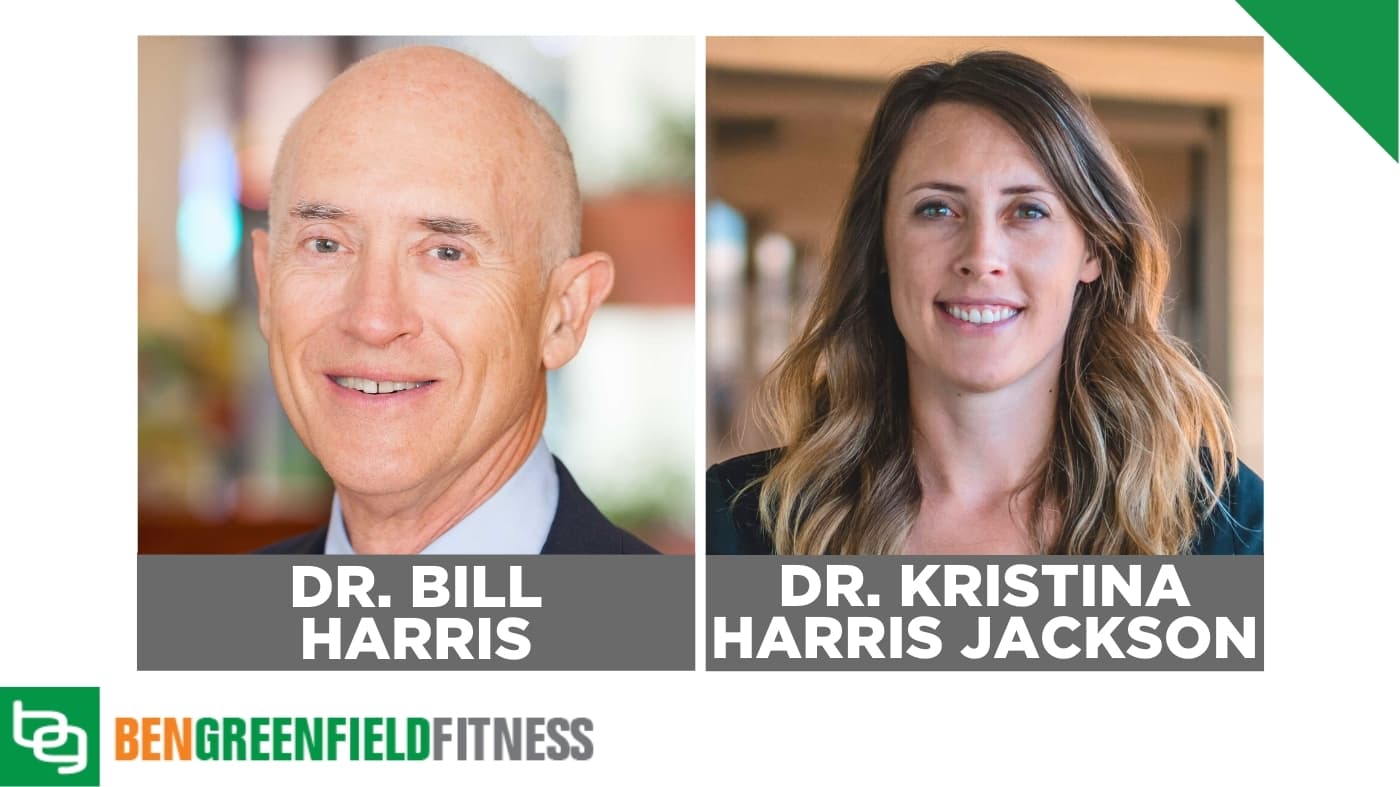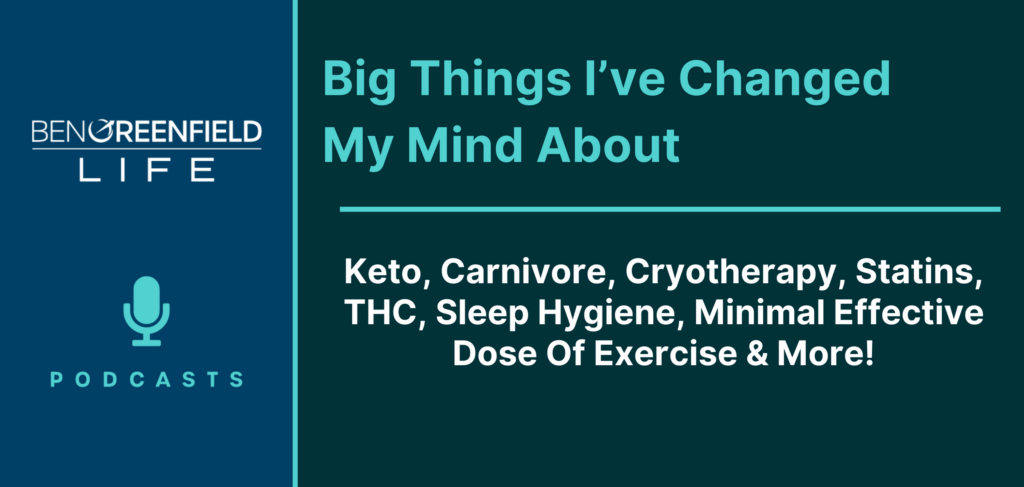November 21, 2020
After publishing my recent giant fish oil article, “A Deep “Dive” Into The Fascinating World Of Fish Oil, The Right Fat Ratios In Your Diet, Plant Vs. Animal Based Oils & The Exact Fish Oil Ben Greenfield Uses Every Day,” discussing fish oil and omega 3:omega 6 fatty acid balance in this recent podcast, and even launching a brand new fish oil called Kion Omega, I've been getting plenty of questions about fish oil, including:
- Based on human clinical research, what are the actual proven benefits of fish oil?
- What kind of dosages/types of fish oil were used in studies?
- Are there concerns about rancidity/oxidation when taking fish oil?
- What EPA/DHA ratio is ideal?
- Are there people who shouldn't take fish oil?
- Are there certain nutrients or supplements that should be taken with fish oil?
- How can one test their omega fatty acid status?
- And many more.
So, I finally decided to get a couple of true, unbiased fish oil experts on my show.
Dr. William S. Harris, an internationally recognized expert on omega-3 fatty acids and how they can benefit patients with heart disease is my first guest. He obtained his Ph.D. in human nutrition from the University of Minnesota and did post-doctoral fellowships in clinical nutrition and lipid metabolism at the Oregon Health Sciences University.
Dr. Harris' interest in omega-3 fatty acids began with his postdoctoral work when he published his first study on the effects of salmon oil on serum lipids in humans. Since that time, he has been the recipient of five NIH grants for studies on the effects of omega-3 fatty acids (EPA and DHA) on human health. He has more than 300 publications relating to fatty acids (including omega-3s) in medical literature and was an author on two American Heart Association scientific statements on fatty acids:
- Fish Consumption, Fish Oil, Omega-3 Fatty Acids and Cardiovascular Disease
- Omega-6 Fatty Acids and Risk for Cardiovascular Disease
Dr. Harris is a professor in the Department of Medicine in the Sanford School of Medicine at the University of South Dakota and the president and CEO of OmegaQuant.
Dr. Harris' daughter, Dr. Kristina Harris Jackson, Ph.D., RD is my second guest. Dr. Jackson received her Ph.D. in nutritional sciences from Pennsylvania State University in 2013 and completed her training to become a Registered Dietitian in 2014. As a graduate student, she studied under Dr. Penny Kris-Etherton, an internationally-recognized expert in fats and nutrition. She worked as a postdoctoral fellow at the University of Colorado, Denver under Dr. John Peters in the area of worksite wellness before returning to the omega-3 field.
Dr. Jackson joined the family business, OmegaQuant Analytics, as a research associate in 2014, with a particular focus on omega-3s in maternal health, helping create the Prenatal DHA test and the Mother’s Milk DHA test. In 2020, she became assistant professor in the Department of Internal Medicine at the University of South Dakota Sanford School of Medicine. She lives in Sioux Falls, South Dakota with her husband, two kids, one old dog, and four grandparents.
During this discussion, you'll discover:
-The 2 sources of omega-3 fatty acids…8:35
- Plant-derived fatty acid alpha-linolenic acid (ALA), 18 carbons; an acid in the omega-3 family – not the same thing as the fish-derived omega-3
- Fish derived eicosapentaenoic acid (EPA), 20 carbons and docosahexaenoic acid (DHA), 22 carbons
- Cannot get much of the good stuff from ALA (seeds and nuts)
- Algal oil from microalgae (single-cell organism, not kelp) that make EPA/DHA naturally; at the base of the marine food chain
- Omega-3 fatty acids are made by plants, not fish
- Some companies grow these algae in big ponds, harvest the omega-3 fatty acids, and put in capsules
- Vegan-derived EPA/DHA products have exactly the same molecules as EPA/DHA derived from fish, but does not come from fish, it comes from algae
- Process is expensive
- Aquaculture industry is driving the demand for algal oil
- 70-80% of fish oil produced is fed back to the fish
- Other sources of fish oil are genetically modified land plants
- Canela seed oil; Australia is at the forefront of putting genes into oil-producing land plants, such as soybeans
-What makes essential fatty acids so essential…15:45
- Cell membranes, made up of fatty acids, surround every cell in the body
- For structural aspect of the cell
- Provides starting products for different signaling pathways, affects how cells communicate internally and externally
- Membrane fluidity; more carbon and double bonds make cell membranes more flexible and fluid
- Cell membranes are comprised of dietary fats
- The body can’t make the essential omega-6 fatty acids (linoleic) and omega-3 fatty acids (ALA, EPA, and DHA); these come from the diet
- Trans-fats are also dietary fats
- Other fats, like saturated fats and monounsaturated fats, are affected by metabolism
-Omega-3 fatty acids being oxidized once they enter the body is a misconception…19:36
- Oxidation has different meanings to a biochemist and a food scientist
- Oxygen molecules are added to the fatty acids by enzymes in order to be activated
- Lipid peroxidation destroys, produces unwanted by-products; does not happen inside the body because of the different antioxidants that protect against this type of oxidation
- Article: Oxidized fish oil does not influence established markers of oxidative stress in healthy human subjects: a randomised controlled trial
- The body has ways of cleaning up things it doesn’t want
-Ratio of omega fatty acids in the body and what the ratios should be…25:32
- Ideal ratio of EPA to DHA is in fish
- EPA taken alone increases EPA and decreases DHA a little bit; increased omega-3 index – the measure of EPA/DHA in red blood cells (RBC)
- Pure DHA taken alone increases both EPA and DHA in RBC
- DHA is the predominant omega-3 fatty acid in membranes
- 85% DHA to 15% EPA in RBC
- In fish oil, total dose (EPA+DHA) is the important thing
- A study found the ideal optimum fatty acid levels (EPA+DHA) to be 8-12% index
- Ratio of omega-6 to omega-3
-Ethyl ester and triglyceride forms of omega-3 fatty acids…33:20
- Different ways omega-3 fatty acids are processed and concentrated
- Ethyl ester is the first highly concentrated form; first to be concentrated into a capsule
- Triglyceride form is the more natural form (how it would be present in fish)
- Most fish oil supplements in the U.S., if it does not indicate it is in triglyceride form, is an ethyl ester
- No standardized way to know if it is triglyceride or ethyl ester
- Biggest difference as far as bioavailability goes is if supplements are taken with meals
- Ethyl esters, if taken without a meal might not be absorbed at all; absorbed well if taken with a meal, preferably a meal that contains fats
- Triglycerides are not affected as much by that meal component as ethyl esters
- All pharmaceutical brands of fish oil are ethyl esters
- More EPA and DHA molecules in a 1 gram capsule if in ethyl ester form
- Distinction only came up around 15 years ago when ethyl ester form of fatty acids was seen as not well-absorbed by the body when taken on an empty stomach
- Taking ethyl ester form supplements without food might not get the desired omega-3 index result
-Which genes convert ALA or plant-based oil into EPA/DHA…45:15
- Genetic conditions that affect omega-3 fatty acid levels
- FADS genes produce the enzymes that convert ALA to EPA and DHA
- Enzymes also convert linoleic acid to arachidonic acid (polyunsaturated omega-6 fatty acid)
- Natural variations by populations in the kinds of mutations that are present in the FADS genes can affect levels, particularly of arachidonic acid
- Omega-3 EPA/DHA not much affected by the FADS genes
- Major genetic effect driving omega-3 levels in the population is not known
- Is there a genetic effect on the absorption of omega-3 in the population?
- No study on why a certain population has a huge absorption response while in another population, there is hardly any response
- Nomenclature:
- Omega-3 – a fatty acid where the 1ˢᵗ double bond counting from the omega carbon is in the third position
- Omega-6 – a fatty acid where the 1ˢᵗ double bond counting from the omega carbon is in the sixth position
- Cannot be inter-converted
- Plants can convert omega-6s into omega-3s, animals cannot
-Ratio of omega-6 to omega-3 fatty acids…52:17
- “Ratio of omega-6 to omega-3” is imprecise – It’s not clear what type omega-6 or omega-3 is referred to; For example, there are 7 omega-6 fatty acids in the blood
- It also presumes that ALA and EPA/DHA have the same biologic activity or they have the same value when they do not
- The same is also true on the omega-6 side
- To say “total omega-6 to total omega-3 ratio” would also be confusing; it does not say what type fatty acids are there; it does not tell anything about their effect on health – some fatty acids are beneficial and some are not
- You can have very high levels of omega-6 and omega-3 in your blood, or you can have very low levels, and yet have the same ratio
- It also presumes that all omega-6s are bad and all omega-3s are good, which is not true
- Omega-3 fatty acids being good is not questionable
- What’s questionable is the goodness or badness of omega-6s; linoleic acid is not made in the body and has to be eaten
- Studies have shown that high levels of linoleic acid in the blood always predict a lower incidence of heart disease and diabetes, and conversely
- Focus on the omega-3 index is that EPA and DHA are what is missing in our diets; there are plenty of omega-6s
-Link between Omega-6 and inflammation and chronic disease…1:00:18
- High consumption of oxidized PUFAs, primarily found in vegetable oils, which are high in omega-6 fatty acids
- Omega-6 fatty acid that gives rise to eicosanoids in the inflammatory pathway is arachidonic acid, a synthetic product of linoleic acid
- Eicosanoids are associated with an increased incidence of inflammation and chronic diseases like arthritis, cancer, etc.
- Synthesis of arachidonic acid is very regulated; tissue levels remain the same regardless of the amount of linoleic acid consumed… to a point (it eventually runs out if linoleic acid consumption is stopped)
- Higher levels of linoleic acid in the blood means you are eating more of it, which comes from vegetable oil; the only way to get high levels in your blood is to eat more
- For heart disease and diabetes, higher levels of linoleic acid are good for the heart and metabolism; fewer people develop these diseases if they have high levels of linoleic acid
- The best way to decrease the ratio is to increase your omega-3 side; by increasing EPA/DHA, EPA replaces, to some extent, the arachidonic acid
- Having more long-chain omega-3 in the membranes lowers omega-6, correcting the proportion
-Contaminants in fish oil, cleanliness, sourcing; concerns about packaging, shelf life, heat exposure during the manufacturing process…1:06:13
- Article: Children's daily exposure to polychlorinated biphenyls from dietary supplements containing fish oils
- Adding antioxidants makes a lot of sense
- Nitrogen-blanketed environment during encapsulation
- Fish oil “gone rancid” does not necessarily mean the omega-3 fatty acids are gone, it just smells bad; the bad smell is caused by any number of 6 molecules
- The best way to know the fish oil supplements are working for you is by testing
- OmegaQuant Omega-3 Index Test
-And much more!
Click here for the full written transcript of this podcast episode.
Resources from this episode:
–OmegaQuant Omega-3 Index Test
-Articles:
- Oxidised fish oil does not influence established markers of oxidative stress in healthy human subjects: a randomised controlled trial
- Children's daily exposure to polychlorinated biphenyls from dietary supplements containing fish oils
- Fish Consumption, Fish Oil, Omega-3 Fatty Acids, and Cardiovascular Disease
- Omega-6 Fatty Acids and Risk for Cardiovascular Disease
Episode sponsors:
–Kion Omega: If you're ready to upgrade your fish oil, head over to getkion.com and grab Kion Omega. Use code BEN10 to save 10% off your order.
–Organifi Red Juice: Enjoy all the benefits of the 11 superfoods and their micronutrients that help increase resting metabolism, support cardiovascular health, and remove toxins to turn back the hands of time! Receive a 20% discount on your entire order when you use discount code BENG20.
-Four Sigmatic: I’ve been using Four Sigmatic products for a while now and I’m impressed by the efficacies of their mushroom products. I use them. I like them. I support the mission! Receive 15% off your Four Sigmatic purchase when you use discount code BENGREENFIELD.
–Thrive Market: Organic brands you love, for less. Your favorite organic food and products. Fast and free shipping to your doorstep. Receive a gift card worth up to $20 when you begin a new membership.














Hey Ben, I’d like to support, since this was such a great rundown. I don’t see a link to an algae source. Got one?
Hi Ben! Thanks for your info. I’ve avoided Omega 3 for years because of Ray Peat PHD’s research. I am a not a biochemist, I’m just a girl with chronic illness, no help, listening to brilliant people have very contrasting views on what is necessary to heal (of course some topics are about customization). However, Ray Peat basically suggests absolutely no Omega 3’s should be consumed for any human. From what I recall, Omega 3’s oofer a short term gain (lowering inflammation like a steroid) but with long term pain/payback for the intake, and it takes 3 yrs to remove from body with strict guidelines. Most studies seem short term, not looking at the boomerang effect. I understand you’ve take it for a long time but also have an amazing toolbox to counteract any negative feedback. I have no idea what to think, but since Omega 3 is conventionally suggested, much like hormone D which is not safe at high levels either… I’m curious, have you dove down that route of Ray Peat’s research? Cheers! :)
There’s also this: https://examine.com/nutrition/fish-oil-and-major-cardiac-events-meta-analysis/
The data seems to suggest it’s less potent than once thought.
It’s interesting how everyone reacts differently to a certain dose of Omega 3 fish oil. The William Davis undoctored protocol calls for 4 grams of EPA/DHA per day. 6 grams if you have elevated lp(a). I’ve been taking that amount for months and I’m at 5.8% blood levels. Been taking the Carlson brand. Switched to Kion and will test with Omega Quant in 3 months again.
Hi, great deep dive into fish oil! My father has high triglycerides, a problem according to his doctor. I want him to take good fish oil for general health, but the ‘triglycerides form’ of fish oil is confusing because it suggests ingesting more triglycerides! What’s going on here, can anyone help me differentiate between the triglycerides please. Perhaps sticking to the ethyl ester form to play it safe? Most grateful.
Best,
I wish krill oil had been discussed. Seems to be below the radar for many.
We’ll have to wait for the KION Krill Oil supplement.
Tell me why Ray Peat is wrong: https://raypeat.com/articles/articles/fishoil.sht…
I already did if you scroll down in the comments section here.
Hi Ben,
Have you delved into what Atom Bergstrom states about lipifuscin (which I only just heard of) and Omega-3s? Love all you do!
Thanks,
Rachael
Stay tuned for more on this!
Will do. Thank you Ben!
Ben’s answer is not here but over in the comments section on this page: https://bengreenfieldfitness.com/article/supplements-articles/omega-3-benefits/
He also brings up the subject with the experts in this interview and they confirm that oxidation (going rancid) of oils outside the body has absolutely nothing to do with the oxidative process within our bodies that is part of the natural functioning of our cells and mitochondria. Ray Peat and others are conflating two distinct processes when they talk of oxidation in vivo. Reading over at “fire in a bottle” (check website or listen to Ben’s recent interview with Brad Marshall) We can see that oxidation in vivo is natural and necessary and happens constantly in our cells, though it is a brief step in a dynamic process.
Interesting episode! I was actually surprised by their views on linoleic acid being good for you. That is very contrary to most of what I have seen.
I have a question about maintenance levels for omega 3. Once you get your level to 8-12%, is there anyway to know what would be a good maintenance level of Omega 3 oil to take Other than guessing and testing again in 3-4 months? Thanks so much.
Agreed! I’m very skeptical about this….I’m not aware of any interventional studies showing this, only association studies. If anyone has links to these studies he’s referring to in claiming this I’d love to check them out!
Are children required to have the same omega 3 ratio as adults?
Just ordered tests for the family but proposing they come back with a deficiency do Healthy omega 3 Levels needed vary with age?
Thanks for this episode. Having your detail oriented mind ask the experts such specific questions was really helpful.
I got the Omega 3 Index Complete from OmegaQuant level last month have a 7.06% Omega 3 index.
I take 1000 mg of DHA and 600 of EPA plant based supplements daily. I have been vegetarian/vegan for 25 years (no fish ever) so it is possible for vegan/plant based eaters to get their omega 3s (although to get to 8-12% I need to make a slight increase to my dose).
I don’t want to say anything that would compete with Kion supplements but I found a brand that when I buy in bulk (3 months supply) I get my daily dose to about $1 day.
So it is both possible and not too expensive to get optimal levels of Omega 3s from vegan/plant based sources.
I do wish the lay person could understand what they are saying. I appreciate that Ben Greenfield is not a dumbed down type of podcast but there is a balance.
Here it is:
1) Take fish oil. 2) test for your levels and shoot for 8% + Most people have lower levels. 3) take at least a gram (1000 mg) of total Omega 3s daily (if not more) and test again in 3 months to see if it’s going up. If not, take more. If it’s up to 8% or more, then you may be able to reduce daily dosage.
Notes:
If you can find your omega 3 supplement in “trigliceride” form (like the Kion version) then it’s bioavailable with or without food.
Otherwise, most come in a different form and you must take with food for them to enter your blood efficiently.
Doesn’t matter what the mix of DHA and EPA is. The other version, ALA though, is perhaps not adequate for most metabolisms to get you the versions you really need, which are DHA and EPA.
You might get enough omega 3 from fish already if you eat like a Japanese.
Omega 6 is not bad in these expert’s view, so they don’t worry about lowering Omega 6 intake, just focus on raising omega 3.
Ben – it appears the fish oil supplement may not yet have made it onto the Kion website. I clicked through the link provided near the end of the post and even searched the Kion website but no mention of Kion branded fish oil.
On a side note, a few supplements routinely give me headaches when I try them and fish oil happens to be one of them. I’ve tried many of the top brands but always with the same result. I’ve tried all the different sources and again same result (algae, krill, salmon). Do you possibly have any ideas on it? I was going to try the Kion brand just to see as well but again the product is not yet appearing on the site. Thanks and always love your podcasts and materials. You still have the best book on health optimization in the industry BY FAR! :)
where did you get your algae omegas?
Check the webside
www..healthio.sk
Balance oil vegan with polyfenols
This is the best EU Omega3 for me
https://www.zinzino.com/2009284575
Ben, I was curious the best time to take a fish oil. I did a wellness FX test 2 years ago but will reach out to
Dr. Bill Harris to get a current test to see where my levels and ratios currently stand.
I so much appreciate what you do. You are my go to guy on many topics.
I prefer with food (listen to podcast for why) in morning with breakfast…
not good. selling fish oil.